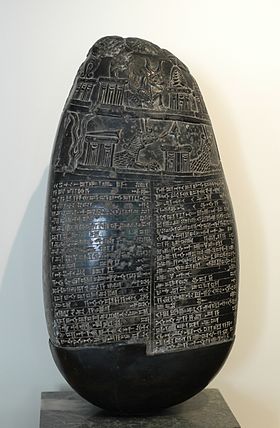
Back كودورو Arabic Kudurru Azerbaijani Kudurru Catalan کودورو CKB Kudurru German Κουντουρού Greek Kudurru Spanish Kudurru Basque کودورو Persian Kudurru French

A kudurru was a type of stone document used as a boundary stone and as a record of land grants to vassals by the Kassites and later dynasties in ancient Babylonia between the 16th and 7th centuries BC.[1][2][3] The original kudurru would typically be stored in a temple while the person granted the land would be given a clay copy to use to confirm legal ownership.[4] Kudurrus are often linked to what are usually called "ancient kudurrus", land grant stones from the third millennium (typically Sargonic and Ur III) which serve a similar purpose though the word kudurru did not emerge until the 2nd millennium (Middle Babylonian in fact).[5]
- ^ Paulus, Susanne. "10. The Babylonian Kudurru Inscriptions and their Legal and Sociohistorical Implications". Volume 1 Karduniaš. Babylonia under the Kassites 1, edited by Alexa Bartelmus and Katja Sternitzke, Berlin, Boston: De Gruyter, 2017, pp. 229-244
- ^ Kathryn E. Slanski, "The Babylonian entitlement narûs (kudurrus) : a study in their form and function", Boston : American Schools of Oriental Research, 2003 ISBN 089757060X
- ^ Brinkman, J. A. “Babylonian Royal Land Grants, Memorials of Financial Interest, and Invocation of the Divine.” Journal of the Economic and Social History of the Orient, vol. 49, no. 1, 2006, pp. 1–47
- ^ J A Brinkman, “Remarks on Two Kudurrus from the Second Dynasty of Isin.” Revue d’Assyriologie et d’archéologie Orientale, vol. 61, no. 1, 1967, pp. 70–74
- ^ I. J. Gelb, P. Steinkeller, and R. M. Whiting Jr, "OIP 104. Earliest Land Tenure Systems in the Near East: Ancient Kudurrus", Oriental Institute Publications 104 Chicago: The Oriental Institute, 1989, 1991 ISBN 978-0-91-898656-6 Text Plates
© MMXXIII Rich X Search. We shall prevail. All rights reserved. Rich X Search